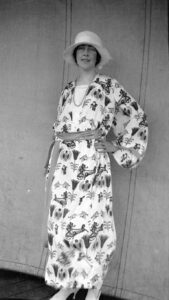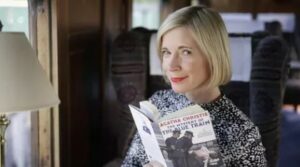PBS Series “Agatha Christie: Lucy Worsley on the Mystery Queen”
![]() Mystery Scene: Thursday, November 30, 2023
Mystery Scene: Thursday, November 30, 2023
A decade ago, British TV presenter Lucy Worsley examined her nation’s obsession with crime.
“Every murder tells a good story,” she said of the British docu-series A Very British Murder, which investigated the real crimes that influenced novelists such as Charles Dickens, Agatha Christie, and Graham Greene, and the filmmaker Alfred Hitchcock.
More recently, Worsley has become best known for a spate of programs with a regal hook, many with her name attached. It’s hardly surprising: The Oxford graduate is chief curator at Historic Royal Palaces, the independent charity responsible for maintaining such iconic sites as the Tower of London and Hampton Court Palace. Recent hosting credits include Lucy Worsley’s Royal Myths and Secrets, Lucy Worsley’s Royal Palace Secrets, and Lucy Worsley’s Royal Photo Album, to name but a few.
Ah, but she hasn’t forgotten her criminal past.
Agatha Christie: Lucy Worsley on the Mystery Queen (note the title’s regal reference!), debuts Sunday, December 3, 2023, with two subsequent episodes on December 10 and 17, on PBS, PBS.org, and the PBS App.
During a recent Zoom roundtable interview session, Worsley discussed the production and her Christie compulsion, giving a nod to a Christie trope when she quipped, “If our Zoom call were an Agatha Christie story, I’m telling you, the murderer would be one of us.”
The series builds on Worsley’s critically admired 2022 biography, Agatha Christie: An Elusive Woman, and she hopes it will further debunk misconceptions, including the forgivable impression that the mystery author was always gray-haired and of AARP status.
“She wasn’t like Miss Marple,” Worsley said, referencing Christie’s elderly spinster crime-solver. On the contrary, when Agatha Christie came to fame, explained Worsley, “physically, she was young, she was blonde, she was strong, she liked surfing and driving fast cars.”
The series weaves period and contemporary footage with interviews with various experts—including other Christie historians, mystery writers, and authorities on topics including the women of World War I, psychiatry in the 1920s, and archaeology, the latter a subject that would profoundly affect Christie’s life.
To illustrate parallels between events in Christie’s life and her writings, Worsley was filmed visiting significant locales, including an archaeological dig where Christie met the man who would become her second husband. Scenes of Worsley making her way through a Middle Eastern marketplace appear in black and white, grainy effects simulating vintage footage. There are also reenactments, as much a popular element of Worsley’s shows as her blonde bob, bright lipstick, and unmistakable narrative delivery (She has difficulty with the letter “r”).
Utilizing materials from Christie archives, Worsley gets to show viewers the first-ever detective story penned by Christie. It’s a kind of spoof, written for a hospital magazine when Christie was with the Voluntary Aid Detachment, working with injured World War I veterans. A harbinger of the signature story elements to come, the piece involves a murder, poison, and a close circle of suspects. For Worsley, discovery of the piece was “a super wow moment.”
There are additional revelations, most notably involving Christie’s headline-making 11-day disappearance in 1926. In the series, Worsley calls the subsequent search for the author “the biggest manhunt yet seen in Britain.” No less an authority than Arthur Conan Doyle, creator of the great Sherlock Holmes and a noted believer in the supernatural, tried to aid the quest—by enlisting the help of a psychic.
For dramatic effect, Worsley visits the same rustic site where Christie’s automobile was found abandoned.
It was at a spa hotel, 230 miles north of where she was last seen, that Christie was finally found. She had checked in using the name of her cheating husband’s mistress.
Both in the series and during the interview session, Worsley expressed ire that many people at the time, and still today, considered the disappearance a publicity stunt to sell books.
Calling such speculation “deeply wrong and deeply unfair,” Worsley added, “She was ill,” carrying out her actions while in “a fugue state” not unlike the shellshock that afflicted veterans of World War I. Further, Worsley believes Christie sought help for memory loss following her breakdown. After consultations with the Royal College of Psychiatrists, Worsley and her team were able to pinpoint the treating psychiatrist. “And you won’t hear about him anywhere else because he’s a new discovery in our program.”
There’s even a photograph of the doctor, which Worsley proudly presents to the cameras. She cites one of the titles Christie wrote under a nom de plume—unknown to readers during most of her lifetime—as a thinly veiled account of what really happened.
In Grant’s Bread, written under the Christie pseudonym Mary Westmacott, a woman with an unfaithful husband loses her memory, and goes on to be aided by a doctor who sounds an awful lot like the same man who may have treated Christie. There are six Mary Westmacott books, and while none are mysteries, Worsley believes they are “vital for understanding the real Agatha,” revelatory in regard to Christie’s personal life. At the time the Westmacott books were written, the pseudonym shielded Christie from scrutiny. “Even as her books were getting more and more globally successful…,” Worsley explained, “she became ever sort of more meek and more humble and never let anybody into her process, if you like.”
Christie’s mysteries, on the other hand, were game changers for the genre. It was she who famously startled readers with a story told by an unreliable narrator (a work Worsley discusses in the series following a helpful spoiler alert). Christie also popularized “mysteries of the past”—aka historical mysteries (Murder in Mesopotamia). The ABC Murders is one of the earliest of the serial killer genre. The Mousetrap, which remains the longest running play in the world, illustrates the power of raiding from true crime; the show includes a segment on the horrific child abuse case that inspired the story.
The series doesn’t sidestep the controversy that some Christie materials are today deemed politically incorrect or insensitive. A segment discusses the book that was eventually retitled And Then There Were None (and, in the United States, Ten Little Indians).
 Worsley is up-front about Christie’s disapproval of various screen adaptations of her work. As a “control freak,” said Worsley during the roundtable, “[Christie] didn’t like the idea of people taking and messing with her characters.” Pressed about specific depictions, Worsley said that Christie wouldn’t have given a thumbs-up to any actor portraying her characters. That includes David Suchet’s popular depiction of the famed detective on TV’s long-running series, Agatha Christie’s Poirot. No matter that it holds special meaning to Worsley. “I mean, this is how I came to Agatha Christie. I used to watch it on Sunday nights at my granny’s.”
Worsley is up-front about Christie’s disapproval of various screen adaptations of her work. As a “control freak,” said Worsley during the roundtable, “[Christie] didn’t like the idea of people taking and messing with her characters.” Pressed about specific depictions, Worsley said that Christie wouldn’t have given a thumbs-up to any actor portraying her characters. That includes David Suchet’s popular depiction of the famed detective on TV’s long-running series, Agatha Christie’s Poirot. No matter that it holds special meaning to Worsley. “I mean, this is how I came to Agatha Christie. I used to watch it on Sunday nights at my granny’s.”
Worsley also grew up in the shadow of Sherlock Holmes—“who I absolutely love.” Worsley’s next venture, Killing Sherlock, will examine the life of creator Conan Doyle, and “the kind of toxic relationship he had with his hero.”
For now, fans of both Worsley and the enigmatic Christie can enjoy the series dedicated to the writer whose first success, The Murder of Roger Ackroyd, was published nearly 100 years ago. Worsley’s personal charm and exuberance, and her knowledge of the great Christie, makes for a production that’s every bit as satisfying as sitting down with a good mystery.
###
 back to writings
back to writings
